Portal de l'Angel - Barcelona Shopping in historic street
Former monastic land evolved into Barcelona's centrally located, designer brands, shopping street with late opening hours
About Portal de l'Angel - Barcelona Shopping in historic street
Avenida Portal de l'Angel has evolved from former Monastic land into one of the most popular and well known fashion shopping streets in Barcelona, known for its desiner casual brands such as Zara, Stradivarius, Pull & bear, Mango and many more.
Along the east side of Portal de l'Angel are more commercially focused stores than the west side, offering not only clothes but jewellery, gifts, souvenirs, underwear and accessories. Musicians and bands regularly play in the areas closer to Catalunya Square and in front of El Corte Inglés, Spain's premier department store.
At the top of portal de l'Angel there is a handcrafted items market selling mostly jewellery. Note also the large 22 metre high Cottet Thermometer (opticians and historic lens maker, they built some lenses and instrumentation for Fabra Observatory) on the side of the buildings. It weighs 2000 kg and at the time of it's inauguration on February 25 1956, was the largest thermometer in the world.
Portal de l'Angel is a pedestrianised street and can be considered an extension of the Passeig de Gracia shopping street that extends from Avenida Diagonal to Plaça de Catalunya.
A complete list of the shops can be found in the visiting section.
History of the Portal del Angel area
Portal del Angel hundreds of years ago was a space where medieval knights tournaments and jousts were held. Later was land owned by the former monastery de Santa Maria de Montsio. Portal del Angel is located just outside what was once the Roman walls Of Barcino (Roman Barcelona).
Documentation from the 12th century shows that the Order of the Holy Sepulcher in Barcelona received an important donation of land outside the Roman wall in the area currently occupied by Canuda, La Rambla, Plaza Catalunya and the Portal del Angel. Monks settled on these fields and the area began to be known as the Villa Sancti Sepulcri.
By 1177 the monks had the church of Santa Anna under construction. In the 13th century Portal del Angel underwent expansion due to the arrival of the Friars del Saco religious order. By the 15th Century, as well as being a monastery, convent and church, Portal del Angel was also a place where Noble families such as Albi, Cruilles, Perelada, Soterra, Marquises of Vilana, Marquises of Barbara, Marquises of Santa Pau and the Cardonas built thier palaces. At this time portal de Angel was where Jousting took place. With the arrival of the Order of Dominican women, the convent that the Friars of El Saco had founded, was renamed Santa Maria de Montsio
The 17th to 19th Century was a period of wars between France and Spain (the war of the Segadors, the Corpus de Sangre, the Nine Years War) During the siege of Felipe de Borbon in 1714 a bomb fell on the church. The convent was confiscated by Napoleonic troops. Later the building became military barracks and the militia that inhabited the convent (to obtain financial resources) decided to create a choir and set up a theater that held its first performance in 1837. Thus, the Montesion Philodramatic Lyceum was born, the origin of the current Gran Theatre of the Liceu.
Under the reign of Isabel II, the old convent became a free public school for singing, music theory, violin, dancing and it had its own orchestra. The first opera to be performed was Norma (1838), which was followed by different operas by Rossini, Bellini, Mercadante and Donizetti.
During 1842 Liceu de Montsio was bombarded again. After this Queen Isabel II convinced the Government to cede the convent of the Trinitarians on La Rambla to El Liceu where the current Liceo theatre now stands.
The Marti Puig family (textile magnates) bought the properties of Montsio and a period of urbanisation began. Pedro Marti Puig, had a house built by the architect Alexandre Perich at the current number 24 of Portal del Angel. In 1892, the Marti family land to the Societat Catalana per l'Enllumenat per Gas (Catalan Gas lighting company) Which latr became Catalana de Gas y Electricidad then the current Naturgy. The Gas company built thier headquarters in Portal del Angel in 1895 selling the building in 2001 to move into their larger headquarters on the site of a former gas factory in Barceloneta. This building previously was the home of a H&M clothing store but will soon be a Lefties clothes store.
Francisco Marti commissioned Josep Puig i Cadafalch to build a house for him on calle Montsio number 3 which is famous because
Els Quatre Gats brewery opened on its ground floor in 1897. This area during the period of Catalan Modernism became a hangout for many artists such as Ramon Casas, Santiago Rusinol, Isidre Nonell, Isaac Albeniz, Enrique Granados, Pablo Picasso and Lluis Millet.
Now when you go shopping in Portal del Angel take a moment to visit Santa Ana church in Calle de Santa Anna 29. Take a moment to admire the old Gas natural building and if possible enjoy a meal in Els Cuatro Gats restaurant.
This section about the history of portal del angel is abridged and translated from an article by the New Barcelona Post.
Image Gallery for Portal de l'Angel - Barcelona Shopping in historic street
Click on any of the 25 images to open full screen gallery player
Visiting Portal de l'Angel - Barcelona Shopping in historic street
Portal del Angel has many of the high street brands including those below with amplified opening hours.
- Monday to Saturday: 10:00h to 21:00h or 22:00h
- Closed: Public holidays and Sundays
Portal del Angel Store Opening Hours:
For Clothes, footwear and accessories shopping on a Sunday or Public Holiday, Maremàgnum Shopping Complex in Port Vell is open seven days a week.
What to take with you for Portal de l'Angel - Barcelona Shopping in historic street
Bicycle anchorage points can be found infront of El Corte Ingless in Portal del Angel. Bicycles in this part of town have a high probability of being stolen so do not take your eyes off it.
Portal de l'Angel - Barcelona Shopping in historic street Summary of Prices
Getting to Portal de l'Angel - Barcelona Shopping in historic street
Address: Portal del Angel S/N, Barcelona. 8002
Nearest metro, FGC and Renfe rodalies train station is plaza Catalunya on the green (L3) line and red (L1) of the metro network. Use a T-Casual or Hola-Barcelona travel card.
Map of Portal de l'Angel - Barcelona Shopping in historic street
Weather for Barcelona
Where to stay overnight in the Portal de l'Angel Shopping Zone
Things to do near Portal de l'Angel - Barcelona Shopping in historic street
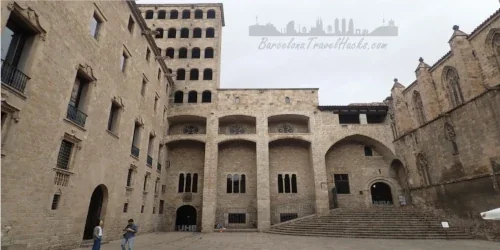 METRO
METROBarcelona City History Museum MUHBA Plaça del Rei
Ground floor is a large vault over preserved roman street ruins with extensive artefacts. The museum is inside Roman buildings and medieval palaces
Read more >
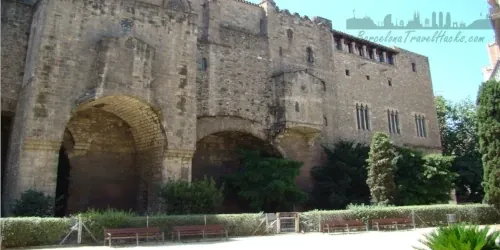 METRO
METRORoman Wall Remains & Plaça Ramon Berenguer III
The remains of the Roman wall run through Plaça Ramon Berenguer III (horse statue) and along Carrer de la Tapineria to Plaza Dels Traginers
Read more >
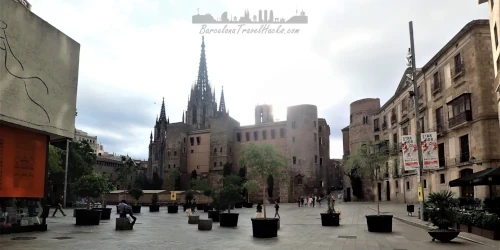 METRO
METROBarcelona's 14th Century Gothic Cathedral
Catedral de la Santa Creu i Santa Eulàlia in the Gothic Quarter. Visitor info, tickets & images from the cloister, cathedral & roof terrace
Read more >
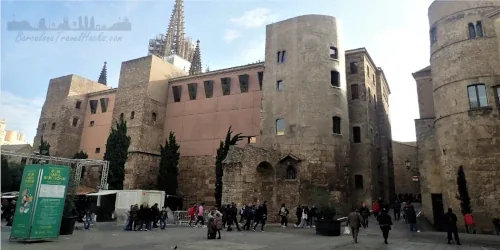 METRO
METROCasa de la Ardiaca - Archdeacons house - city archives
Beautiful interior courtyard, exhibition space & roof terrace. Building also houses the Barcelona historical archives and is built into the Roman city walls
Read more >
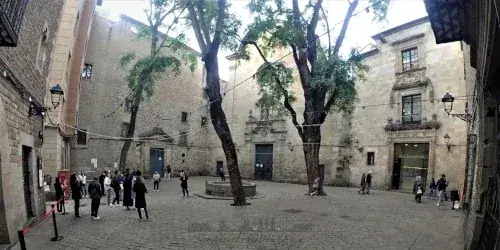 METRO
METROPlaça Sant Felip Neri with baroque church & fountain
Quaint secluded Gothic public square with baroque church showing bomb scars from the civil war, fountain and historic guild houses
Read more >
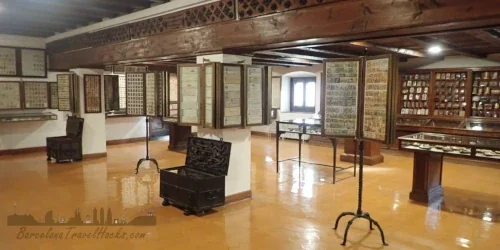 METRO
METROFrederic Marès Museum - sculptor's collections
Collections donated by Frederic Marès - twentieth century Catalan sculptor & renowned collector. Housed in part of the Palau Reial Major
Read more >
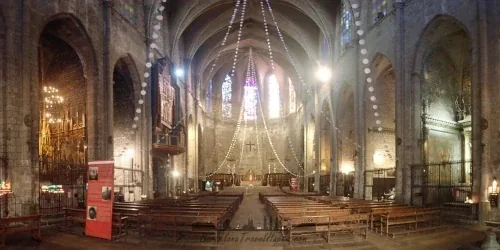 METRO
METROSanta Maria del Pi Basilica Guided Tours & Exhibitions
14th century Gothic Basilica offering extended tourist visits to crypt museum space, garden, exhibition room, treasures room and bell tower roof tour.
Read more >
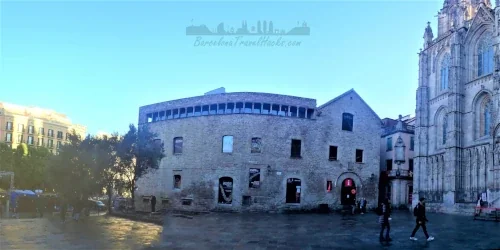 METRO
METRO